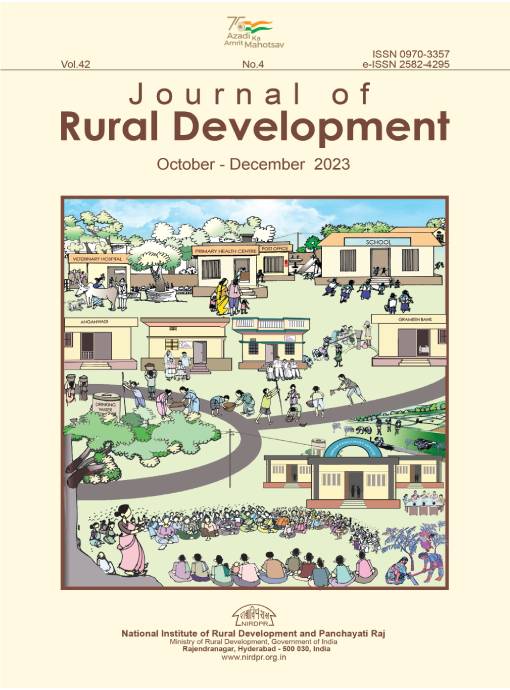Impact of Kanyashree and Sabooj Sathi Schemes on the Development of Rural Areas in Southern Part of West Bengal, Eastern India
DOI:
https://doi.org/10.25175/jrd/2023/v42/i4/171208Keywords:
Kanyashree, Sabooj Sathi, Rural Development, Early Marriage of Girls, Student’s Empowerment.Abstract
Kanyashree and Sabooj Sathi schemes are two noteworthy welfare schemes sponsored by the West Bengal government to develop the rural areas in the state. Kanyashree scheme was launched to check the early marriage of girls whereas the Sabooj Sathi scheme was aimed at empowering the students among the weaker sections of society. The present paper attempts to study the scenario of Kanyashree and Sabooj Sathi schemes, and their role in the development of rural areas in the southern parts of West Bengal in eastern India. The entire work is based on primary data and samples have been selected from three districts, i.e. Purba Medinipur, Paschim Medinipur, and Howrah. Ten sample villages were selected among the three districts and 150 samples were chosen through the purposive sampling method. Average and percentage methods and applied cartographic techniques have been considered for analysis and drawing inferences. Kanyashree remarkably controls the early marriage of girls, reduces the different social barriers that promote the marriage of teenage girls, and broadens the scope of their education. The funds generated for Kanyashree scheme are directly transferred to the beneficiaries’ accounts to meet their private coaching fees, and purchase of educational equipment. Bicycles are provided to the beneficiaries of the Sabooj Sathi scheme to make commuting to school, private coaching centres and playgrounds easy. Family members of the beneficiaries are also using bicycles to reach various places, thereby availing the scope of using it for non-academic purposes associated with numerous important domestic matters. The study found that both the schemes, i.e. Kanyashree and Sabooj Sathi contribute to empowering girl students in the study area.
Downloads
Downloads
Published
How to Cite
Issue
Section
References
Bhattacharya, S., & Deb, P. (2020). A Study on Searching for Freedom: A Theme of Kanyashree Girls of Chakdaha Community Development Block in Nadia District of West Bengal. European Journal of Molecular and Clinical Medicine, 7(8), 5785-5797.
Biswas, H.K. (2021). Impact of Kanyashree Prakalpa on Educational Progress of School Going Girls: A Case Study of Domkalblock in Murshidabad District of West Bengal. International Research Journal Modernization in Engineering Technology and Science, 3(1): 1103-1108.
Biswas, S (2018). Impact of Sabooj Sathi Scheme on Development of Rural Girls Education in West Bengal. NSOU-Open Journal, 1(2): 1-4
Census of India (2011), District Census Handbook, Purba Medinipur, Registrar General and Census Commissioner of India, New Delhi.
Chakraborty, S., & Kundu, P. (2022, August 13). Girls are Mature in the Environment of Work. Ei Samay, p.13.
Halder, U.K. (2018). Kanyasrre Prakalpa: Elaboration of the Objectives. Journal of Education and Development, 8(15): 259-265
Jamal, S., & Hoque, J (2021). Impact of Kanyashree Scheme on Enrolment and Retention of Muslim Girls at Secondary Level in West Bengal. In S.A.Shaikh (eds.) Minority Education and The Way Forward (pp119-134). New Delhi: Hidayat Publishers and Distributors.
Kanrar, N.R. (2018). Impact of Kanyashree Project on the Academic Development of Students: A Study with Special Reference to Howrah District of West Bengal. International Journal of Research and Analytical Reviews, 5(3): 266-275
Mondal, S. (2020). Child Marriage and Kanyashree Prakalpa: Exploring Perception and Attitude Changes among Adolescence Girls. International Journal of Innovative Science and Research Technology, 5 (11): 648-654
Sau, S., Das, P., & Bisai, S. (2019). Rural Development - Some Reflections with Reference to India. Gangchil, Kolkata
Satyarthi, K. (2022, August 8). Social Diseases are Not Solved if Poverty is Not Reduced. Ei Samay, p.8
Sen, A., & Dutta, A. (2018). West Bengal’s Successful Kanyashree Prakalpa Programme Needs More Push from State and Beneficiaries. Economic and Political Weekly, 53(17): 1/8-6/8.
Wheeling Education: An Assessment of the Sabooj Sathi (Cycle Distribution) Scheme for School Students of West Bengal. Pratichi Institute, Commissioned by the Department of Backwards Class Welfare, Government of West Bengal, September 2017.






